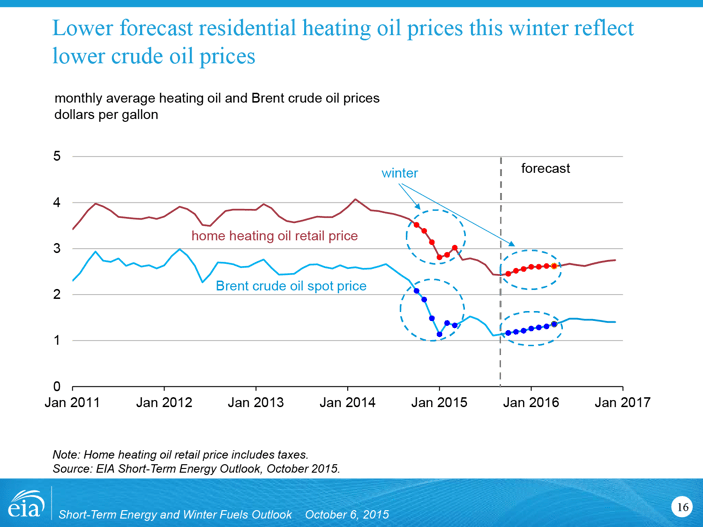Another Great Example of What a Clean Heat Standard Can Do for Us
Our organization has been advocating for a Clean Heat Standard (CHS) in both Massachusetts and Rhode Island. A...
On October 6, the Federal Energy Information Administration (EIA) projected that heating your home with oil will cost 25 percent less than last year and heating your home with natural gas will cost 10 percent less due to a nice combination of lower prices and a forecast for warmer weather. Temperatures for each month from October through March are expected to be higher than the 10-year average. For heating oil customers, this winter could cost $500 or $1000 less than last winter.
The feds expect crude oil prices to stay fairly stable this winter, but there is always uncertainty in the market for crude oil. However, they expect more stability in the distillate market (oil used for home heating, trucks, and power plants) because supplies of refined oil are quite high.

Natural gas prices are expected to be lower than last year, but the difference won’t be quite as large as for oil. Because New England is becoming increasingly over dependent on natural gas for electricity production, this is welcome news for electricity consumers. According to National Grid, electricity rates in Massachusetts for the period running from November 1 through April 30 will be 19 percent or about $10 per month less than for the same months last year. New winter rates for National Grid in Rhode Island and Eversource in Massachusetts are expected to be announced any day.
It should be noted that the utility’s six-month rate is actually a compilation of six, separate one-month rates. And when you look at the monthly differences between last year and this year for National Grid in Massachusetts, you see that January and February’s rates are down a whopping 30 percent. Last year and the year before we experienced high electricity rates because of increased use of gas for power generation during cold snaps a few days in January and February. Prices spiked in late afternoon and early evening when heating systems were at full blast and everyone had lights on.
Fortunately, the New England electricity market has responded in many ways. According to the EIA, on-peak electricity prices in January 2016 are trading at about 9 cents per kilowatt hour, compared to 19 cents in January 2015. This data calls into question the wisdom of building the Kinder Morgan “Northeast Direct” gas pipeline and having electricity ratepayers pay the bill for financing the pipe. That seems to be the policy of Massachusetts Governor Baker, even though such an odd cross-subsidization would be unprecedented.
We beg to differ with the Baker administration. First of all, the Massachusetts Global Warming Solutions Act requires annual reductions in greenhouse gas emissions. Adding more natural gas for decades is simply not compatible with the GWSA. Furthermore, we should not pay for a pipeline 365 days per year for decades if our main problem is meeting winter peak demand during a few hours of the hear. This is not in the interests of ratepayers in Massachusetts and Rhode Island.
The Federal Energy Regulatory Commission (FERC) may approve the Kinder Morgan pipeline. Furthermore, lawyers for for the Massachusetts Department of Public Utilities have opined that there is no legal impediment to charging electricity ratepayers for natural gas infrastructure. But legislators in every New England state should come to the realization that sticking electricity ratepayers with a long-term natural gas bill is bad policy.
We are looking forward to the results of a study commissioned by the Massachusetts Attorney General Maura Healey, paid for by the Barr Foundation. Our hope and expectation is that the study will point out that there are more cost-effective ways than a gas pipelines to meet our winter peak demand challenge – beginning first with energy efficiency and targeted demand response, but including renewables like solar and wind. Mass Energy recently joined colleagues in submitting comments to the Attorney General’s Office reiterating the importance of a comprehensive energy solution that does not increase reliance on natural gas in order to address our electricity constraints on the coldest days of the year.
We will conclude this blog with a couple of undeniable facts:
It’s time to choose.
Our organization has been advocating for a Clean Heat Standard (CHS) in both Massachusetts and Rhode Island. A...
Here’s some news! Our organization has legally changed its name to Green Energy Consumers Alliance, Inc. This...
Comments